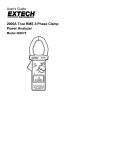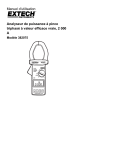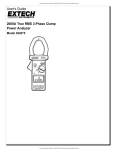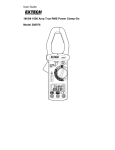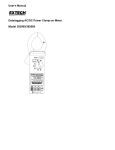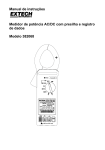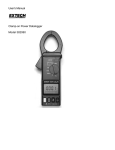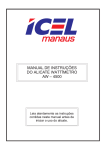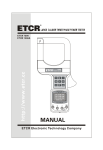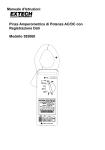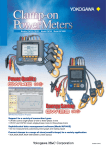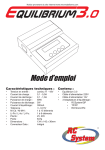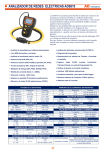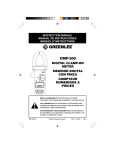Download EX-382075 Gebruikershandleiding / Manual
Transcript
User's Manual Model 382075 3φ/1φ Power Clamp-on Meter Introduction Congratulations on your purchase of the Extech Model 382075 Auto Range Power Clamp-On Meter. Careful use of this device, will provide years of reliable service. Meter Functional Description 1. Transformer Jaw Used to sense current signal. To measure current or power, the conductor under test must be fully enclosed by the jaw. Figure 1 2. Transformer Trigger Press to open the jaw. 3. Data Hold Button Press to freeze most recent reading on the LCD. Press again to release. 4. Function Select and On/Off Switch Select desired function, such as KW, V, A, KVA, or 3φ. 5. LCD Display 4-digit (9999 count) display with function symbols, units, decimal point, low battery icon, and zero indication. 6. Units Symbols Once a function is selected, the corresponding unit (KW, V, A, Phase, KVA, or 3φ) will be displayed. 7. 3φ3W and 3φ4W Select Button If the 3φ system is not a balanced system, users can press this button to select 3φ3W, 3φ4W or a balanced system. Once the button is pressed, the LCD displays 3φ3W or 3φ4W depending on the function selected. 8. Read/Next Button • When the rotary switch is set to the 3φ function, the READ/NEXT button is used as a NEXT button. In the 3φ balanced mode, pressing the NEXT button will display W+PF, KVA+KVAR, or V+A data. • In the 3φ3W mode, pressing the NEXT button stores the measured values WRS(L1L2) and WTS(L3L2). After two values are measured and stored, the meter adds the two values, displays the result with the symbol WRST to represent W3φ3W. To start another W3φ3W measurement, press the NEXT button again. • In the 3φ4W system mode, press the NEXT button to store the measured values WR(L1), WS(L2) and WT(L3). After three values are measured and stored, the meter adds the three values, displays the result with the symbol WRST to represent W3φ4W. To start another W3φ4W measurement, press the NEXT button again. • If the rotary switch is not set to the 3φ function, the READ/NEXT button is used as a READ button. Stored data in memory (saved by pressing the REC button) can be read by pressing READ. 9. & 10. V and COM Input Terminals Used as positive and negative (common) inputs for voltage measurements. 11. DC A/W ZERO button Press this button once to zero the Amp or Watt display. While the meter is zeroing, the word ZERO appears the LCD. 12. REC button Press the REC button to store up to 4 data points in meter memory. Operating Instructions NOTE: Ensure that the jaws are clear of any conductors before applying power to the meter. The meter performs an auto zero upon power-up to null any residual magnetism. If this is done with a conductor inside the jaw area, the auto zero function will cause subsequent measurements to be inaccurate. DC/AC 1φ2W Power (W) and Power Factor (PF) measurements 1. Apply power to the meter with the jaws clear of any conductors. 2. Set the rotary switch to the Watts function (KW). 3. If the watt reading is not zero, press the DCA/DCW ZERO button once to zero it. 4. Insert the test leads into the input terminals. 5. Connect the COM (black) terminal to the neutral line. 6. Connect the V (red) terminal to the power line. 7. Clamp on to the line where the V (red) terminal is connected. The power clamp will automatically select the proper measurement range. Read the Watt and PF (Power Factor) values displayed on the LCD. 1 Phase 2 Wire Current > 1 Phase Load Figure 2 NOTE: The "+" sign printed on jaw must face the power source for accurate measurements. AC/DC Voltage Measurements Voltage (V) and Frequency (Hz) Dual Display WARNING: Maximum input voltages: 1000VDC and 750VAC. Do not attempt to measure voltage that exceeds these limits. 1. Set the rotary switch to the Voltage position (V). 2. Insert the test leads into the input terminals. 3. Connect the test leads in PARALLEL with the circuit to be measured. 4. The power clamp will automatically select the proper range. 5. Read the voltage and Frequency values displayed on the LCD. NOTE: The sensitivity for voltage/frequency measurements is 1V, and the frequency range is 10 - 400Hz. If the frequency is < 10 Hz, the LCD will indicate 0 Hz. If the frequency is > 400 Hz, LCD will show OL. Voltage(V) / Current (A) Dual Display Follow the instructions in the section entitled "3φ Balanced Power Measurements" to monitor V and A simultaneously. Figure 3 AC/DC Current Measurements Current (A) + Frequency (Hz) Dual Display WARNING: 1. When applying power to the meter, make sure the clamp jaws are not near a conductor. 2. Make sure that test leads are disconnected from the meter during current measurements. 1. Set the rotary switch to the Amps position (A). 2. Push and hold the DCA/DCW ZERO button to zero the reading. 3. Press the trigger to open the jaw and fully enclose the conductor to be measured. The Jaws must be completely closed to make a measurement (see Fig.4). 4. Read the current/frequency values on the LCD. NOTE: The sensitivity for current/frequency measurement is 5A, and the frequency range is 10 - 400Hz. If the frequency is < 10 Hz, the LCD will display 0 Hz. If the frequency is > 400 Hz, LCD will display "OL". Figure 4 Voltage (V) and Current (A) Dual Display Follow the instructions in the section entitled "3φ Balanced Power Measurements" to monitor Voltage and Current simultaneously. DC/AC 1φ2W Apparent/Reactive Power Measurements (KVA+KVAR) NOTE: Before taking any measurements, zero the current (A) reading and set the rotary switch to the KVA position. Follow the steps listed in section entitled DC+AC 1φ2W Power (W) and Power Factor (PF) measurement for these measurements. KVAR is a calculated value, and its accuracy greatly depends on the accuracy of the V, A, and KW readings. To obtain a more accurate KVAR value when PF is greater than 0.91 (φ < 25°), measure the phase angle and obtain the KVAR from the following equation for a pure sine wave: KVAR = KVA * sin φ Phase Angle Measurements 1. 2. 3. 4. 5. 6. 7. 8. Set the rotary switch to the A position. If the current reading is not zero, press the DCA ZERO button. 1 Phase 2 Wire Current > Set the rotary switch to the Phase position. 1 Phase Insert the test leads into the input jacks. Connect the test lead inserted in the COM (black) Load terminal to the reference line. Connect the test lead connected to the V (red) V terminal to the voltage signal under test. -23.8 Clamp on to the wire where the V (red) terminal is XL o A connected (see Fig.5). If current signal is detected from the jaws, the phase angle will be displayed in degrees on the LCD together with the frequency of the voltage. If current is not detected, only the frequency of the Figure 5 voltage will be displayed while the phase angle display will be left blank. NOTE: Zero the current (A) reading before measuring to avoid incorrect Phase Angle readings. INDUCTIVE LOAD: A negative phase angle indicates that the current signal lags the voltage signal. A negative phase angle also indicates an inductive load. CAPACITIVE LOAD: A positive phase angle indicates that the current signal leads the voltage signal. A positive phase angle also indicates a capacitive load. NOTE: The "+" sign printed on the clamp jaw must face the power source for correct readings. 3φ Balanced Power Measurements Power (W) and Power Factor (PF) Dual Display 1. Apply power to the meter with the jaw clear of any 3 Phase 4 Wire R(L1) conductors. S(L2) 2. Set the rotary switch to the 3φ position. T(L3) 3. The LCD will show 3φ3W, 3φ4W, and BAL N symbols to indicate balanced mode. 4. If the watt reading is not zero, press the DCA/DCW ZERO button once to zero reading 5. Insert the test leads into the input terminals. 6. Select one phase (R or L1) as COM and Connect Figure 6 the COM (black) terminal to the same phase just selected (R or L1). 7. Connect another test lead to the second phase (S or L2). See Fig. 6. 8. Clamp on to the third phase (T or L3). 9. The power clamp will automatically select proper range. 10. Read the Watt and PF values displayed on the LCD. 11. To view the KVA and KVAR data, press the NEXT button. 12. To view V and A, press the NEXT button again. 13. To return to the W and PF display, press the NEXT button again. Current > 3-phase Bal. Load KVA/KVAR Dual Display Follow steps 1 through 10. in the above section and press the NEXT button. Wait approx. 2 seconds for the LCD to display the KVA and KVAR. Voltage (V) and Current (A) Dual Display Follow steps 1 through 10 in the above section and press the NEXT button twice. Wait approx. 2 seconds for the LCD to display Voltage (V) and Current (A). NOTE: Specific selection of each phase is not required in 3φ balanced power measurement mode. As long as each test lead and the jaws are connected to different phases, the reading is always correct. The "+" sign printed on jaw must face the power source for accurate measurement. NOTE: To find out if a load is capacitive or inductive, refer to the section entitled "Phase Angle Measurements". 3φ3W Unbalanced Power Measurements Two measurements WRS (or WL1L2) and WTS (or WL3L2) are required. Refer to Fig. 7. 1. First measure WRS (or WL1L2) a. Apply power to the meter with the jaw clear of any conductors. b. Set the rotary switch to the 3φ position. c. Press the 3φ button once, the 3φ3W symbol will display on the LCD. At this moment, the WRS symbol flashes prompting the user to begin measurement of WRS. d. If the watt reading is not zero, press the DCA/DCW ZERO button once to zero reading e. Insert the test leads into the input terminals. f. Select one phase (S or L2, for example) as COM and connect the COM (black) terminal to that phase (S or L2). g. Connect V (red) terminal to the second phase (R or L1). h. Clamp on to the same phase as in step g. (R or L1). The power clamp will automatically select the proper range. i. Wait until the reading stabilizes, then press the NEXT button. The WRS (WL1L2) symbol will disappear. At this moment, WRS is stored in memory, and the WT (WL3L2) symbol appears flashing to prompt the user to take the WTS (WL3L2) measurement. 2. Secondly, measure WTS (or WL3L2 ). Refer to Fig. 8. a. Disconnect the test leads and jaws from the lines in the previous measurement. b. Connect the test leads to the third phase (T or L3). c. Open and close the jaws, be sure that no conductor is in the jaws. d. If the watt reading is not zero, press the DCA/DCW ZERO button once to zero the reading. e. Clamp on to the third phase where the test lead is connected (T or L3) f. The power clamp will automatically select proper range. g. Wait until the reading stabilizes, then press the NEXT button. The WT (or WL3L2) symbol will disappear. At this moment, WTS (or WL3L2) data are stored in memory, Once the NEXT button is pressed (after measurements of WRS (or WL1L2) and WTS (or WL3L2)), the power clamp will add the two values and display the result on the LCD. The WRST symbol appears indicating that the reading shown is the wattage of the 3φ3W unbalanced Power. PF is not shown in the 3φ3W unbalanced power mode. W3φW = WRST = WRS(L1L2) + WTS(L3L2) 3 Phase 3 Wire WRS (L1L2) 3 Phase 3 Wire WTS (L3L2) R(L1) Current > R(L1) S(L2) 3 Phase Load 3 Phase Load S(L2) T(L3) Current > T(L3) FIGURE 8 FIGURE 7 NOTE: Once a phase is selected as the COMMON connection, users cannot change this selection in the subsequent measurements. For example, if S (or L2) phase is selected, S (or L2) phase is always connected to the COM of the power clamp during measurements of WRS (or WL1L2) and WTS (or WL3L2) in 3φ 3W unbalanced power mode. NOTE: The "+" sign printed on the jaw must face the power source. NOTE: In the 3φ3W unbalanced power measurement mode, WRS or WTS could be a negative value. Users must make sure all the connections are correct to obtain correct power readings. 3φ4W Unbalanced Power Measurements The measurements of WR(or WL1), WS(or WL2), and WT(or WL3) are required for these measurements. 1. First, measure WR (or WL1) (Fig. 9). a. Apply power to the meter with the jaw clear of any conductors. b. Set the rotary switch to the 3φ position. c. Press the 3φ button twice, and the 3φ4W symbol appears singularly on the left side of the LCD. The WR symbol will flash prompting the 3 Phase 4 Wire WR (L1) user to take the WR. measurement Note: If the watt reading is not zero, press the R(L1) Current > DCA/DCW ZERO button once to zero S(L2) 3 Phase reading T(L3) Load d. Insert the test leads into the input terminals N e. Connect the neutral line to the COM (black) terminal. f. Connect the V (red) terminal test lead to the first phase (R or L1). g. Clamp on to the same phase (R or L1). h. The power clamp meter will automatically select the proper range. FIGURE 9 i. Wait until the reading is stable, then press the NEXT button. The WR symbol will disappear. Now, WR is stored in the memory, and the WS symbol flashes prompting the user to take the WS measurement. 2. Measure WS (or WL2) (Fig. 10). WS (L2) 3 Phase 4 Wire a. Disconnect the test leads from the phase where the jaw was clamped onto as R(L1) Current > described in the section entitled "3φ 3W S(L2) 3 Phase T(L3) unbalanced power measurements". Load b. Connect V (red) terminal to the second N phase (S or L2). d. If the watt reading is not zero, press the DCA/DCW ZERO button once to zero reading e. Clamp onto the phase where the test lead is connected to (S or L2 phase) FIGURE 10 f. The power clamp will automatically select the proper range. g. Wait until the reading stabilizes, then press the NEXT button. The WS symbol will disappear. WS is now stored in memory. 3.Thirdly, measure WT (or WL3). See Fig. 11. 3 Phase 4 Wire a. Disconnect the test lead from the phase WT (L3) R(L1) where the Jaw was connected in the S(L2) section entitled "3φ3W Unbalanced 3 Phase Current > T(L3) Power Measurements". Load b. Connect the test lead inserted in the V N (red) terminal to the third phase (T or L3 phase). d. If the watt reading is not zero, press the DCA/DCW ZERO button once to zero reading e. Clamp onto the phase where test lead FIGURE 11 is connected to (T or L3). f. The power clamp will automatically select the proper range. g. Wait until the reading stabilizes, then press the NEXT button. The WT symbol will disappear and WT will be stored in memory, 4. Once the NEXT button is pressed (after measurements of WR WS, and WT), the power clamp will add the three values WR, WS, and WT together and display the result on the LCD. The WRST symbol will appear indicating that the reading shown is the wattage of the 3φ4W unbalanced circuit. PF is not shown in the 3φ4W unbalanced power measurement mode. W3φW = WRST = WR(L1) + WS(L2) + WT(L3) NOTE: The "+" sign printed on jaw must face the power source. NOTE: In the 3φ4W unbalanced power measurement mode, all three WR or WS and WT readings must be positive. If one is negative, check the connection of the test leads and the clamping of jaw. Make sure test lead and clamp connections are correct to obtain useful power readings. 1φ3W Power Measurement 1φ3W power measurements are similar to 3φ3W unbalanced power measurements except that the nomenclature is different. Two measurements of WRS (or WL1G) and WTS (or WL2G) are required 1. First, measure WRS (or WL1G). See 1 Phase 3 Wire WL1 Fig.12. Current > a. Apply power to the meter with L1 the jaw clear of any conductors 1 Phase Load b. Set the rotary switch to the 3φ G position. c. Press the 3φ button once, and L2 the 3φ3W symbol will singularly appear on the left side of the LCD. 1 Phase The WRS symbol will flash Load prompting the user to measure WRS(L1G). d. If the watt reading is not zero, FIGURE 12 press the DCA/DCW ZERO button once to zero it. e. Insert the test leads into the input terminals. f. Connect the COM (black) terminal to ground. g. Connect the V (red) terminal to the second phase (L1). h. Clamp on to the same phase as connected in step g. (L1). i. The power clamp will automatically select the proper range. j. Wait until the reading stabilizes, then press the NEXT button. The WRS (WL1G) symbol will disappear and the WRS(L1G) reading will be stored in memory. The WT (WL2G) symbol will flash prompting the user to take WTS (WL2G) 1 Phase 3 Wire WL2 measurements. L1 2. Secondly, measure WTS (or WL2G). Fig. 13. 1 Phase Load a. Disconnect the test leads from the G phase where the jaws were clamped onto in the previous measurement. b. Connect the test lead to the L2 line. L2 Current > d. If the watt reading is not zero, press 1 Phase the DCA/DCW ZERO button once to Load zero reading e. Clamp on to the L2 line where the test lead is connected. f. The power clamp will automatically FIGURE 13 select the proper range. g. Wait until the reading is stable, then press the NEXT button. The WT (or WL2G) symbol will disappear. At this moment, WTS (or WL2G) is stored in the memory, 3. Once the NEXT button is pressed after measurements of WRS (or WL1G) and WTS (or WL2G) are taken, the power clamp will add the two values together and show the result on the LCD. The WRST symbol will display along with the wattage of the 1φ3W unbalanced Power. PF is not shown in 1φ3W unbalanced power mode. See equation below. W1φW = WRST = WRS(L1G) + WTS(L2G) Calculation of 3φ4W Power Factor (PF) When measuring 3φ4W unbalanced power, use the REC button to record the individual power factors (KWR(L1), PFR(L1), KWS(L2), PFS(L2), KWT(L3), and PFT(L3)) of each phase in memory. 3φ4W power factor can be calculated using the following equation: KVA KW KW KW R(L1) S(L2) S(L3) = ;KVA = ;KVA = R(L1) PFR(L1) S(L2) PFS(L2) T(L3) PFT(L3) KVA 3φW PF 3φW = KVA R(L1) + KVA S(L2) + KVA T(L3) KW 3φW = KVA 3φW Improving the Power Factor of a 3φ4W Power System Measure the KVARR (or KVARL1), KVARS (or KVARL2 ), and KVART (or KVARL3) values of each phase. Based upon the measured values, a 3φ or 1φ capacitor at the rated voltage and frequency can be used to improve the power factor. To find the value of capacitance, refer to the following equation. Where: KVAR*1000 Capacitance(Farad) = 2 2πfV f: frequency in Hz V: phase voltage It is recommended that the KVAR value of the capacitor a somewhat less than the value measured. Improving the Power Factor of a 3φ Balanced Power System 1. Measure the KVAR 3φ value of a balanced system. 2. Based upon the measured value, a 3φ capacitor at the rated voltage and frequency can be used to improve power factor. 3. To find the value of capacitance, refer to the equation in the section above. 4. It is recommended that the KVAR value of the capacitor be somewhat less than the value measured. Improving Power Factor of a 1φ2W Power System 1. Measure KVAR value of a 1φ2W power system. 2. Based upon the measured value, users can purchase required capacitor at rated voltage and frequency to improve power factor. 3. If value of capacitance is needed, obtain the value via the equation in the section entitled "Improving Power Factor of 3-phase 4-wire System". 4. It is recommended that the KVAR value of the capacitor should be a little less than the value measured. NOTE: The indication of phase sequence is not limited to 3φ balanced power. It can be used in general as long as the Power Factor is greater than 0.1. Phase Sequence Indication (for Power Factor > 0.1) In the 3φ balanced power mode the meter will automatically L3 detect the phase relationship between three individual phases. L3 1. Set the rotary switch to the 3φ position. L2 L1 2. Connect the voltage input (red terminal) to the ‘R’ (or L1) phase, connect the COM input (black terminal) to the ‘S’ (or L2) phase, and clamp on the T (or L3) L3 phase. When clamping onto the T (or L3) phase, the power clamp must face the power source. 3. If the phase sequence is clockwise, R, S, T sequence L1 L2 will flash on the display. L2 L1 4. If the phase sequence is counterclockwise, T, S, R FIGURE 14 sequence will flash. 5. If current is not detected, only one of the R, S or T phases will be represented on the LCD. See Fig. 14. NOTE: The "+" sign printed on jaw must face the power source for correct measurement. Recording Data The power clamp can store 4 data points in memory. To store data displayed on the LCD, press the REC button. If the power clamp already has 4 data points memorized, the LCD will display FULL. The REC symbol will be displayed on the LCD if any data is currently stored in memory. To clear the meter memory, power the meter down. Recalling Data from Memory To retrieve data from memory, press the READ button. NOTE: The rotary switch must not be set to the 3φ function when reading memory data. Once the READ button is pressed, the reference number of the data will be displayed first; the stored measurement data will then be displayed. While in the READ mode, the REC. and No. symbols will be displayed on the LCD. To exit the READ function, select another function using the rotary switch. NOTE: If both the REC and the No. symbols are shown on LCD, the reading shown on the LCD is the data stored in memory, not actual measurement data. Specifications General Specifications Conductor Size Display Sampling time Overload Indication Power Power consumption Operating conditions Dimensions Weight Cable Φ55mm. (approx.) Bus Bar 65mm (D) x 24mm (W) Dual 4-digit 9999 count LCD 0.5 seconds for Voltage and Current; 1.6 seconds for Watts ‘OL’ displayed on LCD 9V Battery (Heavy Duty Type) Approx. 28mA 4°C to 50°C <85% RH 10.7" (L) x 4.4" (W) x 1.8" (H)271mm (L) x 112mm (W) x 46mm (H) 22.8 oz. / 647g (with battery) AC/DC KW True Power (PF 0.2 - 1.0, 3φ3W, 3φ4W, 1φ2W, and 1φ 3W) Balanced Range Resolution 0 - 99.99KW 0 - 999.9KW 10002000KW 0.01KW 0.1KW 1KW Accuracy (of reading) ±2.0% ±0.5KW ±2.0% ±0.5KW ±2.0% ±5KW Maximum Input Current Voltage 200A 500V AC/DC 2000A 600VAC 800VDC AC/DC Voltage (True RMS, Crest Factor < 4, Autorange, Overload Protection 800VAC) Range 0-200V 200-500V 500 - 600VAC 500 - 800VDC Resolution 0.1V 0.1V 1V Accuracy (of reading) DC, 50 / 60 Hz 40 - 400Hz ±1.5% ±5dgts ±2.0% ±5dgts ±1.5% ±5dgts ±2.0% ±5dgts ±1.5% ±5dgts ±2.0% ±5dgts Input Impedance 10MΩ AC/DC Current (True RMS, Crest Factor < 4): Range 0 - 200A 200 - 500A 500-2000A Resolution 0.1A 0.1A 1A Accuracy (of rdg) DC, 50 / 60 Hz 40 - 400Hz ±1.5% ±5dgts ±2.0% ±5dgts ±2.0% ±5dgts ±2.5% ±5dgts ±2.5% ±5dgts ±3.0% ±5dgts Overload Protection AC 3000A AC/DC KVA (Apparent Power) KVA = V*A / 1000 AC KVAR (Reactive Power, PF < 0.91) Range 0 – 1200KVAR Resolution 0.1 / 0.01 Accuracy Remark 1 KVAR or +/-3%rdg+9d (whichever is greater) For more information, refer to the section entitled "DC/AC 1φ2W Apparent/Reactive Power measurements" Phase Angle (User must zero the current reading before taking measurements) Range Accuracy Sensitivity Remark 50/60 Hz V > 100V, A > 10A Zero Crossing Detection ± 2.0° Note: If current signal is not detected, the phase angle will be left blank in LCD. Frequency (if < 10 Hz, then the Hz Display = 0) Range 50/60 Hz 10 - 400 Hz Accuracy ±2 dgts 0.5% ± 2dgts Sensitivity V > 1V, A > 5A Battery Replacement When the low battery symbol appears on the LCD, replace the 9V battery. 1. Remove power to the meter and disconnect all test lead and jaw connections. 2. Remove the screws from the bottom of the meter housing. 3. Lift and remove the meter battery compartment. 4. Replace the 9V battery. 5. Replace the case and secure the screws. Repair and Calibration Services Extech offers complete repair and calibration services for all of the products we sell. For periodic calibration, NIST certification or repair of any Extech product, call customer service for details on services available. Extech recommends that calibration be performed on an annual basis to insure calibration integrity. Warranty EXTECH INSTRUMENTS CORPORATION warrants the basic instrument to be free of defects in parts and workmanship for one year from date of shipment (a six month limited warranty applies on sensors and cables). If it should become necessary to return the instrument for service during or beyond the warranty period, contact the Customer Service Department at (781) 890-7440 for authorization. A Return Authorization (RA) number must be issued before any product is returned to Extech. The sender is responsible for shipping charges, freight, insurance and proper packaging to prevent damage in transit. This warranty does not apply to defects resulting from action of the user such as misuse, improper wiring, operation outside of specification, improper maintenance or repair, or unauthorized modification. Extech specifically disclaims any implied warranties or merchantability or fitness for a specific purpose and will not be liable for any direct, indirect, incidental or consequential damages. Extech's total liability is limited to repair or replacement of the product. The warranty set forth above is inclusive and no other warranty, whether written or oral, is expressed or implied Copyright © 2000 Extech Instruments Corporation. All rights reserved including the right of reproduction in whole or in part in any form Ver. 1.7 Oct 17, 2001













